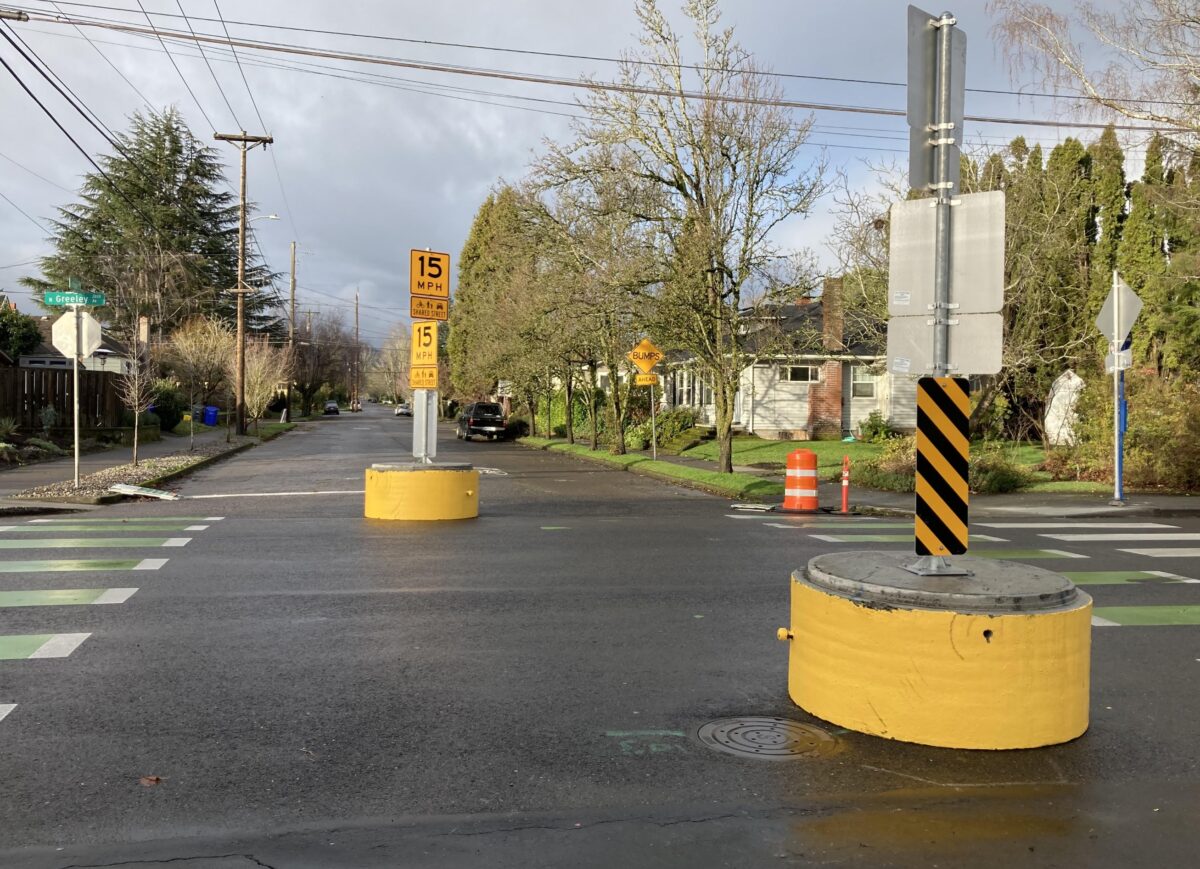
(Photos: Seth Sokol)
“Thanks PBOT! As a frequent visitor to Arbor Lodge Park with my 2 year old, I had experienced a stubborn neighbor repeatedly moving the previous temporary barricades.”
— Seth Sokol, north Portland resident
The Portland Bureau of Transportation (PBOT) is making good on a promise to make neighborhood streets in Portland safer by installing permanent barricades designed to slow drivers down.
After receiving positive community feedback for its ‘Slow Streets’ plan that initially launched in May 2020, PBOT has installed dozens of the concrete planters citywide.
‘Slow Streets’ are part of PBOT’’s ‘Safe Streets’ initiative that began as a response to the COVID-19 pandemic and aimed to lower speeds and cut-through car traffic on select neighborhood greenways so people could safely physically distance outside. PBOT placed orange plastic barrels and a-frame signs on neighborhood greenways at 100 locations around the city, expanding them to over 200 locations upon seeing how successful they were.
But these temporary orange barrels were too easy for irritated drivers to pick up and move (see below). Seth Sokol, a BikePortland reader who found the barriers helpful in creating a safer environment to ride bikes around his neighborhood with his two-year-old son, told us this morning he’d seen someone repeatedly moving the barricades — a scenario that no doubt played out at dozens of other locations citywide.
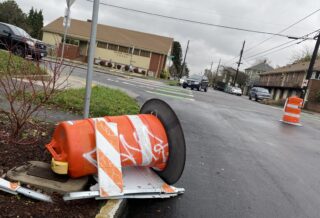
(Photo: Jonathan Maus/BikePortland)
These new concrete planters will be hard to move (they are not filled with concrete as I first assumed, but are simply turned upside-down). As you can see in the photo of North Bryant at Greeley, they’ve also added yellow advisory signs with “Shared Street” and “15 mph” on them. The barricades are also painted yellow and placed far enough into the intersection so they have the added bonus of slowing down cross-traffic on the larger street. And they cost only $1,500 each to install (including signs).
Advertisement
PBOT announced over the summer that the ‘Slow Streets’ program would continue — this time, with permanent concrete structures serving as barriers so they couldn’t be moved so easily. As we reported in August, this was a big deal.
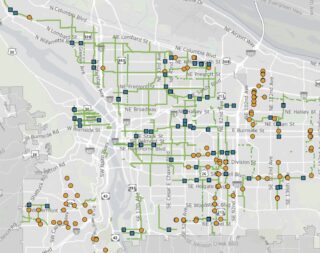
According to the PBOT map of all slow street installations, these barricades in Arbor Lodge count for two of the eight permanent installations in north Portland and the peninsula. PBOT has promised 80 total and a quick citywide count shows they’ve got over 70 and are close to that promised number (we have not verified the accuracy of the map, but PBOT has been good about keeping it updated).
Sokol shared his excitement with us at seeing the flimsy barricades he repeatedly saw being whisked away by a neighbor, get replaced with something much more solid.
“Thanks PBOT! As a frequent visitor to Arbor Lodge Park with my 2 year old, I had experienced a stubborn neighbor repeatedly moving the previous temporary barricades, so this should provide more permanent traffic calming,” Sokol emailed.
Not only is there a park a few blocks from this installation, but there’s also a TriMet bus stop and a school nearby.
When announcing this plan, PBOT shared positive testimonials from supporters who said having barricades in their neighborhood streets made them feel safer walking and biking alone and with their families. One southeast resident told the city they bought bikes for their family for the first time, finally feeling safe enough to freely cycle through their neighborhood.
If you’ve seen any of these barricades, let us know what you think. It’s heartening to see how simple, inexpensive tools like concrete barrels can improve the livelihoods of people who get around Portland without cars and provide encouragement to people who are wary of taking to the streets on a bike.
CORRECTION, 12/16 at 9:45 am: This story initially reported that the planters were filled with concrete. That is not true. They planters are hollow inside and are just flipped upside-down. That means they’re a bit lighter than we hoped. Still too heavy to move by hand, but we can expect (unfortunately) that they’ll still be jostled around by bad drivers. PBOT has said, “Future updates could include using more permanent materials, like poured concrete.” So we’ll see. We regret any confusion.



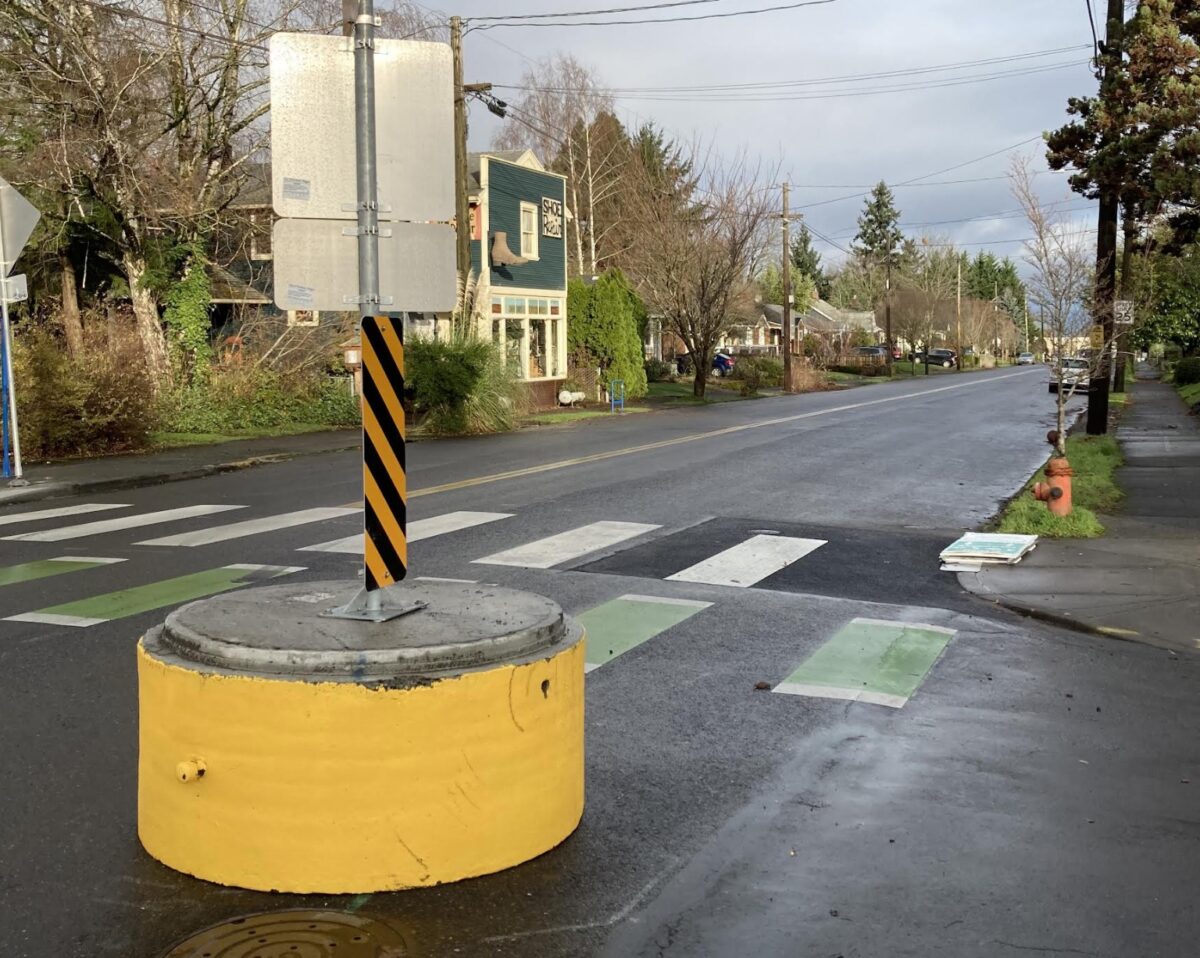
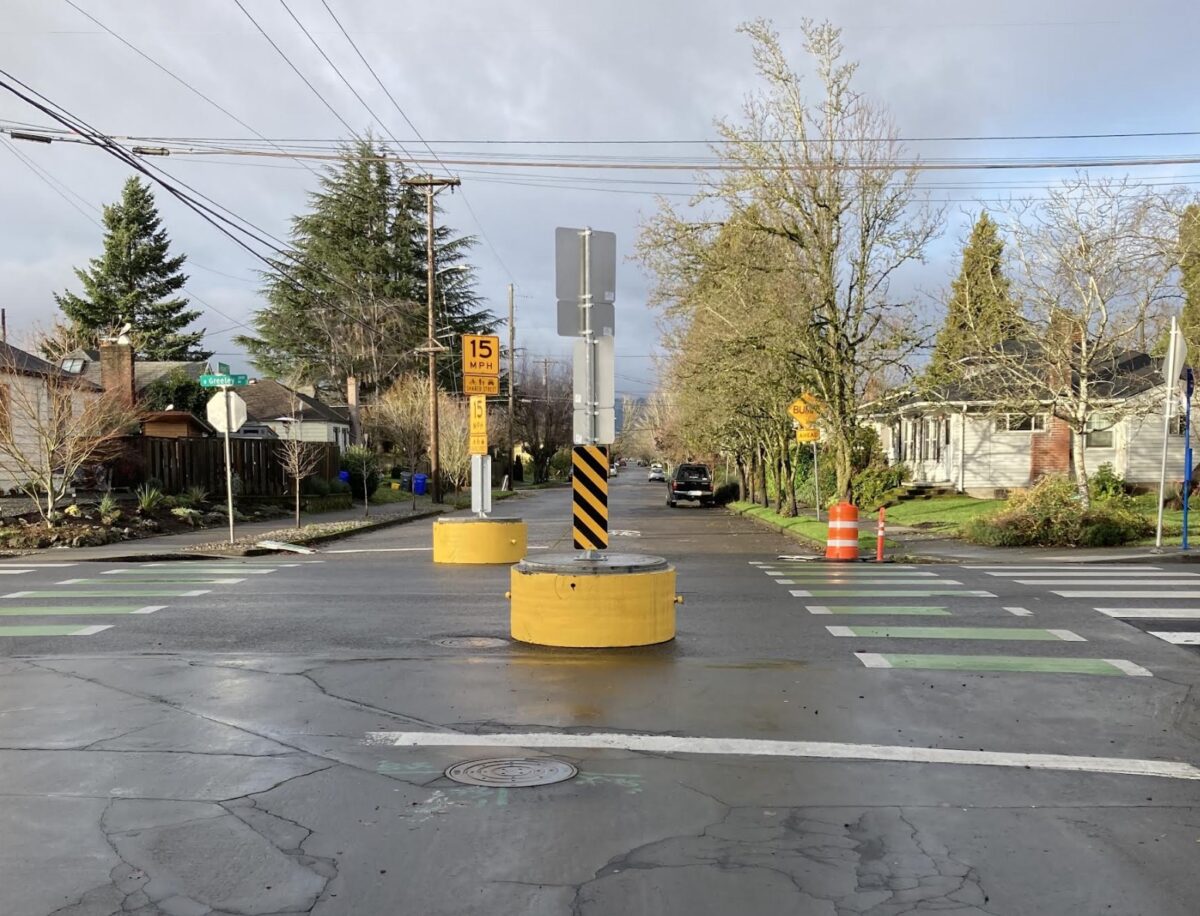

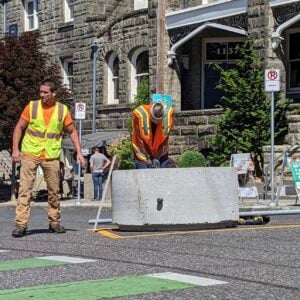
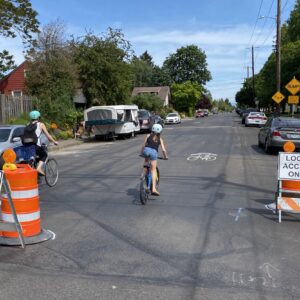

Thanks for reading.
BikePortland has served this community with independent community journalism since 2005. We rely on subscriptions from readers like you to survive. Your financial support is vital in keeping this valuable resource alive and well.
Please subscribe today to strengthen and expand our work.
Grateful to see these go up on Bryant St, been wanting an improvement to Willamette since it was announced. Thanks PBOT. Wish they went all the way through to Williams or MLK. 🙂
Ah yes, the Slow Streets program. A program so useless that PBOT simply left out the data on whether it actually slowed the streets down from the program evaluation.
The reality that PBOT is so motor-centric that we can’t even get real traffic calming measures on greenways is really deflating.
Like, there isn’t a single motorist who is going to change course because of these things. They don’t reduce motorized traffic or slow it down. It’s just a waste of time and money and uses our social capital for no gain.
I disagree cmh89. People will absolutely creep around these things in cars because they know they’ll bang up their precious vehicles if they aren’t careful. These things will absolutely slow turning movements and cross street traffic speeds. I don’t think we need a study for everything – especially when it’s obvious IMO if you put a massive multi-ton barrier in the middle of someone’s driving path they will go slower and change behaviors.
Sure, they’ll slow down for a milisecond or two and then gun the gas pedal to get back to the 30mph they were going before
Maybe they will. PBOT didn’t gather data on this as it wasn’t a goal of the program, unless I’m misremembering something. I’ve never particularly thought much about turning speed. I’m much more concerned with speeding cars passing me with a foot of clearance which is what happens and will continue to happen on our ‘Greenways’.
I don’t think we need a study for this because it is painfully obvious to anyone who stands on the street and watches one of these for about 20 minutes that they do absolutely nothing. Have you ever sat and watched a speed bump? People slow down, go over the bump, and then immediately speed up again. This doesn’t even cause a bump, which makes it even less useful than a speed bump.
It seems like you are moving the goal post on what the original intention of these was in order to make it seem like a win. From your first story on
“Our [greenway] network has been working quite well, this is just an effort to make it safer,” he said. Brady also pointed out that, contrary to popular perception, no streets are being closed. “It’s really important to emphasize that we’re not closing the streets. We want to stop cut-through traffic,” he said. “If people need to get to a business, their homes, or if they have business on that street. Then they treat the street just like any other street.”
The only place I’ve ever seen anyone mention turning speed is from you. The stated goal is to stop cut through traffic. These don’t do that. They also don’t slow down traffic.
I live 1 block from Alberta and Michigan and I will anecdotally say traffic in my specific neighborhood is both LESS and slower. Michigan is really narrow with parking on both sides, traffic humps and a generally disregarded right turn only at the skidmore end of Michigan so that is a combination of things that help to divert cut through traffic and slow what there is. I’d take the cement barriers on the Alberta and Michigan corners for sure!!
How often do you bike during peak SUV/truck cut-through hours on a neighborhood greenway with this infrastructure? Because in my experience drivers still do a pandemic-style fast rolling stop through these intersections and will absolutely buzz a cyclist trying to negotiate the “barricade” at the same time.
I hate them.
I use the N Central ‘Greenway’ in some capacity on a daily basis and I will anecdotally say there are more cut through drivers. I don’t think it has anything to do with the beg signs, but they certainly aren’t helping.
But, PBOT actually studied it. They did a terrible job but they got their samples in July of 2020, when huge amounts of people were working from home and they still didn’t find a meaningful reduction in motorist. They sampled at pretty much the best time for them and still found nothing. I’m sure a sample of today would see an increase in traffic.
These things aren’t going to help but they aren’t going to hurt. My frustration comes from the fact that PBOTs’ stated goal was to eliminate cut through traffic. If that’s true, why not use evidence-based traffic diverter designs?
There are two scenarios here. The first is that PBOT seriously wants to eliminate cut through traffic on ‘Greenways’. If that’s true, PBOT disregarded evidence-based traffic diversion infrastructure design and opted for yet another experimental design that their own data suggest doesn’t slow down motorists or reduce traffic volume.
The second, and in my opinion more likely, scenario is that PBOT officials know full well that these don’t do anything and that’s why they are installing them. PBOT resisted even the temporary beg signs. They are have no interest in actually reducing through traffic on greenways. These beg barrels are performative acts.
It also speaks to the dysfunction at PBOT that these staffers published a program evaluation of a program called ‘Slow Speeds’ that doesn’t mention if the program actually slowed speeds and literally no one, including Maus bothered to ask.
They often don’t creep and they frequently pass/buzz people cycling near these planters in a dangerous manner (just like traffic circles). These concrete planters should be repurposed for diversion, not this faux-traffic-calming theater.
it should be a diverter.
Bingo. We have the same problem up here in Seattle. The city put up all these “Road closed” signs with a barrel or barrier, but they didn’t actually close the road. If they had some conviction they would close the roads to cars with real barriers at one end (this is much less of a big deal here in Seattle, as most homes have their driveway access off of an alley and not the actual road itself, so this wouldn’t have as much impact on residents). Our house sits on a greenway and the route to my daughters school is entirely on this greenway. Every day we get closely followed by cars coming home on these “closed streets”.
Right. This is very similar to road design “suggestion”, akin to maintaining capacity/speed for cars and adding “no speeding” or “no running red lights” signs (eg in DC). While helpful it is a tiny step to having an exponentially larger effect on speed/traffic counts when placed as a true divertor. It is depressing that PBOT will invest in the same material/cost as would go into a divertor and get very little in return.
The one on Greeley had pieces of a headlight lens laying on the ground inext to it. So someone figured it out the hard way.
I’m confused. Will all the orange dots (barrels) in PBOTs map eventually be replaced with green ones (concrete barriers)? If so, what’s the time frame for that to happen?
No. Not all locations have sufficient space.
I encountered the new barrier at Alberta/Concord this weekend while in a car. To use a term I’ve heard PBOT throw around, the intersection didn’t feel very ‘legible’. Traveling west on Alberta, the barrier is on the righthand side of the intersection, and I wasn’t sure which way to go around it to make a left. It definitely does the job of slowing cars down though, and I’m happy to see progress on a major cycling route like Concord.
If still permitted, how do left turns by cars onto Greeley work? Do drivers stop at the limit line, then angle right and make a tight left turn around the barricades? Will cyclists passing on the right in the cross-bike expect that type of behavior?
Do the barricades, specifically the signs coming out of them, obstruct the view of road user? A car might not be able to fully hide behind one, but I can see a driver missing a cyclist as they scan the intersection.
Think they might bea positive step forward to calming drivers speed. But did not notice if the concrete base have reflectors. These would be a good safety feature so drivers can see them at night. I find the recently installed posts in the left turn lanes along 122nd street are hard to see at night. Think installing reflectors installed in the street might be a safety improvement at not much cost.
The one in my neighborhood did not have reflectors earlier this week, but I noticed today that it does have reflectors. And I understand the paint has reflective beads embedded in it.
Definitely appreciating the heftier signs.
The positioning doesn’t seem to be on center, but rather looks to be biased toward constricting the exit from, and expanding the entrance to, the “slowed” street. If we are really trying to slow down drivers – at least for their 3 second turn – shouldn’t it be the other way around?
This is consistent enough that it is a clear installation directive – why not at least be centered??
Oh well, maybe with enough water they’ll expand into real diverters.
Fire truck access.
Even placed in a position to divert cars from entering such as at Clinton and 32nd, fire trucks can still drive around them using the oncoming lane. There is very little traffic on Bryant and the road is very wide. Why install diverters that don’t divert?
Hideously ugly. Couldn’t the put planters there with some nice flowers/plantings?
Are you offering to maintain the plants?
Ugly as sin and a poor replacement for what we really need. ENFORCEMENT of our traffic laws!
Well, they’re not going to exhibit bias and they won’t wander off to Starbucks.
That map of temporary vs permanent installations is not at all accurate or current (or else I/we misunderstand the way PBOT is using those terms). My commute takes me past six positions that are mapped as permanent, but are in reality still those orange barrels that are often moved aside or run into.
I personally find it really sad that we are pre-occupied with these tiny hints of inconvenience for motordom, while truly protected and separated facilities for non-motorized road users remain unpalatable and unthinkable to those with the power to implement them. Such is the society we live in.
“Tiny hints of inconvenience for motordom” sounds about right. I live near the ones on SE 13th and Umatilla, and it’s not clear what they are supposed to do or whether they are achieving it. As discussed in this thread, are they to slow down turn movements? To slow speeds on the greenway itself? To discourage (rather than actually divert) traffic from choosing the greenway? To just make it more confusing to drive in the area so that motorists give up and take alternate routes? (or react with anger and gun it once past those inconveniences?) Maybe these nudges will slowly influence behavior (as in, reducing speeds and re-directign traffic) but it seems like a frustratingly slow and indirect path to get there!
Since the city is building these so slowly, could they put out a how-to guide to build one or let a non-profit build them out a-la friends of trees planting trees in the Right of Way?
It seems like if we’re filling them with concrete we could just have a simple amount of wood framing and some bags of concrete and you’re good to go.
According to the city a few years ago, aside from the cost of building out facilities, the big “roadblock” to implementing more road improvements is getting city engineers to review and approve plans. The city won’t let anything happen in the right of way without this. It may be a fear of law suits.
I’m pretty sure the concrete culverts are hollow and not as solid as PBOT wants you to believe – after all they need to be light enough to move around. But they would still wreck any car or SUV.
I wish we could see the signs on them in the photos. How can these possibly work with out messages on them in some alphabet that only .01% of the population understands??
We motorists had to move them so frequently because the barrel and two A frame signs are almost always placed in a way nobody could literally move past them without getting out and physically moving them…what did you expect people to do? Glad to see these are situated in a way not to impede mobility.
I never had issues driving around these things. Are you operating a Hummer, by chance?
Definitely not. I have small hatchback that gets excellent gas mileage and a motorcycle that can easily dodge all the anti car infrastructure
I have never seen a safe street totally blocked by signs or barrels. What are you talking about? At best they spanned one lane. You might have to wait for a car exiting the slow street before entering it, as was the intention.
I was walking my dad’s dog on Ida Ave. Saw a guy get out of his car to move one of the A frame signs so he could drive the 20 ft to his driveway, chucking it to the side in frustration. Do you think the guy that lived right there on that road was thinking “I want more cut through traffic!”, or “I’m soooo damn sick of people blocking my route home!”?
I have no problem waiting for a car coming the other way…usually going pretty slow looking for pedestrians when I’m turning onto a residential…
If I had my way, all small roads would have diverters at big roads. When does someone need to drive along a small street for so long that they cross a big street? Should be local access only. Maybe garbage trucks would have to redraw their routes.
IMO, diverters should be placed midway between major streets (arterials, collectors). I don’t care if people get into or out of their neighborhoods. It’s people trying to make time through a neighborhood on a ‘greenway’ that parallels a major street that bug me. If they hit a diverter that forces a penalty loop then Waze, et al., will quit pushing that option.
What’s green about greenways? Is there any plan to plant trees or make them better places to be?
One of these useless concrete tubs could function as a semi-diverter in many locations simply by putting them in the greenway lane and adding thermoplastic routing symbols:

Two of them at different locations would function as full semi-diversion (more forgiving to locals who can’t or won’t use micromobility).
– – – – – – – – – – – – – – – – – – – – – – – – – – – – – – – –
The term “Neighborhood Greenwashingway” exists because PBOT was afraid to indicate that a roadway should have active transportation priority.
Yes! Completely agree!
The counterpart to that though, is to not create artificial congestion on the big streets so cars don’t have motivation to cut through. Which would be a win – win for both groups. I don’t understand why that is so frowned upon here
Because congestion on big streets induces traffic evaporation. The more congestion via roadway reallocation/deconstruction, the better.
Right, because everyone has the luxury to not drive…
As a musician that plays all around the region, how should I move my gear around? On a bike? A bus?
My 72yo dad, with his crippled back, that makes frequent trips to the VA. Should he ride a bike there? Spend countless hours on a bus? I ask these sincerely. What is your honest suggestion? I’m all ears.
That’s just me and my experience. Multiply that by all the parents picking up their kids from soccer practice on the way home from work. All the blue collar workers lugging tools around for 10 hours a day. All the people not fortunate enough to have everything delivered to their doorstep. You can’t shame and strongarm everyone into riding a bike or bus. I’m all for mandating smaller vehicles, turning pretty much all residential streets into greenways, promoting alternative transportation (These cold and rainy nights, I’m impressed by you! I’m not going to do it though…) But proudly proclaiming to artificially create congestion for the *face it* majority of people that won’t ride a bike is destructive to the very cause you claim to care about.
Follow the science. The way we do Vision Zero is a lose-lose. Time to get our heads out of the sand
Your dad can still drive to the VA if traffic evaporates.
What study are you referring to that traffic will evaporate by creating artificial congestion?
Traffic evaporation or reduced demand is a well-established and robust phenomenon:

https://nacto.org/docs/usdg/disappearing_traffic_cairns.pdf
https://www.cnu.org/publicsquare/2021/03/19/reduced-demand-just-important-induced-demand
A review:
https://www.icevirtuallibrary.com/doi/full/10.1680/muen.2002.151.1.13
I honestly don’t understand this comment. Why would VA traffic not “evaporate” while other traffic would?
The idea of degrading transportation in order to save it sounds like a strategy from the Army in the late 1960s.
A large percentage of monstrous SUV/truck trips are non-essential, to put it charitably. I would even argue that many of these trips are a result of boredom or lack of Fordist stimulation. In essence, our roads are packed with USAnians cosplaying a driving/racing video game that kills tens of thousands of non-pixelated human beings each year. An illustration of this Fordist phenomenon is the positive correlation of VMT with income.
(Decarbonization requires targeting middle* and upper-class Portlanders with punishing fees/taxes.)
*Portland median income is so high that much of the middle class in this city are upper-income on a national level.
***Comment deleted by moderator*** Please stay focused on the topic, not the person, when making your point. Thanks.
It’s a pity that I can’t see your comment because the subtext of my comment was that your Dad’s trips to the VA are essential travel and should be *subsidized* (and shifted to vehicles with fewer negative externalities). Our increasingly dystopian society can easily afford to implement free and efficient door to door transportation to medical facilities and other essential resources.
Presumably including those on their way to the VA.
I want to be clear that I strongly support making the emissions of CO2 more expensive (it matters less to me whether they’re emitted from a car or a factory). I just don’t understand how you discriminate between “necessary trips” and “boredom driving”, assessing a cost only to the latter.
If public transit is to survive in coming decades it will likely function more like a low-occupancy door-to-door/flexible-stop service than the current system of lumbering and infrequent 30-40,000 lb buses. There are many ways this type of service could function in an equitable manner (for example and in order of my political preference: universal service funded by progressive taxation, progressive access to free rides, allocation of a certain number of free rides to specific demographics etc).
In other words, we agree that transit is on the cusp of a radical transformation into something more closely resembling a taxi service, probably fueled by automation (because the labor costs of human drivers are way too high for this to work).
It is my projection that if such a service works well, it will displace most privately-owned urban cars, thus resolving our endless disputes about concrete cylinders, parking, and other divisive* urban design issues.
*Note the use of divisive, not applied to a female.
I think the most likely outcome in the USA is complete or partial privatization of transit by TNCs with regressive user costs.
I will also add that many market urbanists/YIMBYs have functioned as cheerleaders of transit-undermining TNCs and this is one of the many reasons that I view this ideology as corrosive to the greater good.
The ownership structure is certainly an open question. I don’t think its obviously better for an agency like TriMet to own all the rolling stock; perhaps there will be multiple entities owning multiple competitive fleets, and TriMet may or may not have their own. If trips are cheap enough (comparable to bus fare), we may not even need to subsidize them at all, but even if we do, Uber can still own the cars.
Yep. WFH has eliminated the downtown cores that made mass transit efficient.
Turns out that everyone commuting by SOV is just doing it for “funsies” though…
Censored! Hot damn!! Let me try again without naming names…
What percentage of people (general readership and no one in particular) that cross the interstate bridge on a daily basis do you really believe is just doing it for fun?
~60% of trips are less than 6 miles in length and many of these trips could be reduced or combined without a huge impact on livability. This fits well with data showing that lower income people make ~30% fewer trips than high income folk. I suspect that ~30% of these shorter distance trips could be eliminated without any appreciable impact on livability (even considering our dystopian built environment and transportation system).
The economic difference in VMT traveled is even more stark with low income households traveling ~40% fewer miles per day than higher income households.

Based on this data I would estimate that 30-40% of trips have little essential utilitarian value or are needlessly redundant. And this estimate does not consider the enormous societal incentives to drive versus use of alternative transport options. If this society actually cared about ecocide we could likely implement progressive incentives/disincentives that would rapidly cut down vehicle miles traveled by ~40% without major transportation infrastructure renewal.
Please note the growth in per capita VMT over time:

Okay, you have convinced me that other people make trips I would deem unnecessary. Could you perhaps clarify a bit on how I can better determine whether somebody else’s particular trip is important or not, and how, on a practical level, we adequately disincentivize trips judged “unnecessary” without discouraging the important ones?
I’m bored… going to go do some bridge circuits in my car. Laterz y’all!
@soren – It’s hilarious to me to see another “dad drives to the VA” comment in another city. People were screaming about a street closure in San Francisco for the same reason, even though one would have to detour out of the way to use it to get to the VA hospital.
The exhaust-huffers got their way and got cars put back onto the street. Meanwhile, the other street that goes to the VA hospital is as congested as other. No grasp of traffic evaporation in these parts (even though we’ve seen it happen several times with earthquakes knocking down freeways).
See, this is another straw man. Admittedly it’s a favorite of the transportation-insecure, but “less traffic” in no way equals “force me to ride a bike or take the bus”. If congestion becomes unbearable, those who can will skip a trip, use other means of transport, or make their trip at a different time. Those who like to sit in traffic (which is what they are choosing to do by driving a car), are still free to do so. I see so many drivers with their faces buried in their phones while attempting to also drive–those folks could make good use of some bus time!
I will grant you that we are currently “forcing” people to drive cars–even those who can ill-afford to do so–by making other modes so inconvenient and unreliable as to be useless except as a novelty. I always find it interesting when someone calls travel by means other than a car a “luxury”. If it is so luxurious, why doesn’t everyone do it? We could all feel like royalty!
In your case, is every trip you make to a gig? Or do you sometimes go other places that you don’t have to carry all your equipment? There are lots of folks who could sometimes use a car, and sometimes walk, ride, or take transit–it’s just that the default thinking that “travel” == “car” is so ingrained that almost nobody realizes there’s even anything else on the menu. Here I go with the food again, but most folks tend to go with the steak and french fries regardless of the cost or health implications, when they could actually do a lot better with an occasional salad and grilled chicken.
In other news:
https://www.masstransitmag.com/management/press-release/21249286/trimet-trimet-temporarily-reduces-service-due-to-operator-shortage-starting-jan-9
Here’s a thought experiment to try:
Imagine that somehow, cities were arranged in some segmented, walled-off fashion so that the only real way to get anywhere was in, say, a helicopter. Sounds awesome, until you realize how much a ‘copter and home helipad cost to buy, build, and maintain, and how much space all those helos take up. And holy crap are they noisy–but no other way to get around, so we get used to it. Jokers who got their pilot’s licenses out of cereal boxes fly around in junker choppers and endanger people with their low-flying, and inability to maintain a flight path, and lots of times, a whirlybird drops out of the air onto somebody’s house, or a park, but whaddayagonna do, eh? Sure, there are public cargo birds flown by “professionals”, but they only land at long intervals in inconvenient places, so hardly anybody uses those. Now the city builders aren’t completely heartless, and they’ve left some doorways in the massive wall complex, so if you really want to walk or ride a bike along the dirt paths that have been worn by other weirdos doing the same thing, you can, but…you have to go far out of your way to find a door, and you risk getting lost in the maze of walls and doors, or entering a segment where there is no way out but back the way you came or climbing a wall. And there’s the constant risk of being nailed by a falling aircraft, or maybe just the old cans and junk people always feel like they can just toss out the window as they fly by–and the constant prop-wash! Man! It blows your hat off and ruins you hair, and kicks up a ton of dust and debris that gets in your eyes. So most folks wear “walking goggles” to keep from getting eye injuries, I mean, it’s only common sense, right? Who wants to go blind from irresponsible walking? You can imagine other things a city might do to “accommodate” folks that don’t want–or can’t afford–to use a helicopter: pave some of the dirt paths, say. Or build special tunnels to protect from prop-wash debris and falling helicopters. Maybe cut more doors through the walls, etc. But that stuff is expensive to do (even though cleaning up after ‘copter crashes is really expensive, and building public heliports for landing at the mall and such is really, really expensive) so “accommodation” doesn’t happen very much. I mean, it’s not like people don’t have a legal right walk where they want–none of the wall-doors are locked or anything.
Already too long, but you can imagine what people might “prefer” and why in this goofy scenario. It’s outrageous on purpose, but some parallels definitely apply.
“Artificial congestion” is a complete misnomer. In previous decades, cities have made transportation policy mistakes and given over huge amounts of valuable city space to motor traffic, with negative consequences to peoples’ physical and mental health. Portland is now very slightly reducing the amount of space given over to motor traffic. People can and do continue to drive in huge numbers in that slightly smaller space. Their choices create congestion. It is no more artificial than the distribution of space in any other decade. There is no “natural” space allocation in cities. People often just equate “natural” with “how it used to be when I liked it more”.
This is a good start. But PBOT ought to already be planning to make these into car traffic diverters and adding more and more throughout the city to make our neighborhood streets truly low-stress for those walking, rolling and biking.
Challenge to PBOT: Make our Greenways impenetrable to cut-through car traffic by June 1, 2022. Let’s make summer 2022 the start of our path toward 25% bike mode share by 2030. (25 by 30!)
I’ll never forget two winters ago, while driving my car west on NE Multnomah at MLK waiting to turn left into the Burgerville parking lot… A fast moving driver behind me went to pass me on the right and smashed into the heavy concrete planter that was protecting the cycletrack. The driver couldn’t wait for me to turn, and wasn’t allowed to pass on the right there as there isn’t an extra lane. They couldn’t even see the brightly reflective planter there.
I love these mega bollards. Please put them EVERYWHERE now. It taught that driver (I hope) to slow down and stay in their lane.
I hope they talked to First Student before installing those. A fellow school bus driver was having to (safely) drive onto the sidewalks pushed out onto Hawthorne Blvd last Spring to make the turns to pick up his school kids.
Perhaps they did think about this and that is why they are pushed out onto Greeley (to make enough room for the width of a bus or garbage truck. Of course, there is still no legal way to enter or exit Bryant from Greeley in a 41 foot School Bus. Either way it will require both sides of the street to be clear to make the turn.
I don’t know how these are from a driving perspective, but as a cyclist I really don’t like them. I like to ride in the center of the street, and I find them to be a nuisance. If they keep vehicles off greenways, that’s great, but I am skeptical that these will at all deter someone from driving on a street that they convinced is the best route for them to use (either because of local knowledge or Waze).
Much better than speed enforcement as obstacles are always on the job.
Watching some drivers blow through these in NW today, the 15 mph signs seem at odds with the stop signs. Using them at stop controlled intersections doesn’t seem to create much calming (stop sign plus barrel not much different than just stop sign for drivers going straight; turning movements are significantly affected possibly in a good way if drivers don’t go around them on the wrong side). Will we get the “local access only“ signs back? Those do seem to discourage non-habitual cut-through drivers. Hopefully we can get the bugs worked out and come up with a non-ugly version that people might embrace. These are trying to meet a very important need. I am hoping to see some of these in the middle of intersections to create some horizontal calming where there is not a stop sign.
Local access only signs are unenforceable and a waste of resources.
How does PBOT decide whether to install these as opposed to diverters? Seems like there’s not a big difference in cost, but a huge difference in effect.
I don’t think USAnians will pay local traffic signs any attention. We need signs that forcefully communicate active transportation priority (and these should be made legal via local/state law):


I’d recommend not using Dutch!
The planters are not filled with concrete, they are just installed upside down to reduce costs.
oh darn. Thanks for the insight Paikiala. will edit story.
I live on a corner that got one over the weekend. Tue. morning it had been hit and moved a couple of feet. Then late morning I watched a woman drive into it while turning east. She “didn’t see it.” This morning, as PBOT was relocating it to its appropriate place, another guy hit it…and this was with the PBOT truck almost next to it. For gosh sake people, pay attention!!
I tell ya, make it slightly more difficult to get, and keep, a license, and we’ll get rid of half the traffic overnight. It is far too easy to be a lifelong crappy driver, and that’s a huge part of the problem.
The barricades along with new speed bumps are absolutely making a HUGE difference on my street in outer NE where we don’t have sidewalks and must share our street with walkers, bikers, and motorists.
Was fun the first couple of weeks watching certain vehicles that were used to tearing down our 3 block stretch of street scraping their undercarriage as they bottomed out after flying over the new speed bumps. THANK YOU PBOT!!!
• Those look like great traffic-control devices, but unless you’re actually changing the feel of the street they aren’t “traffic-calming.”